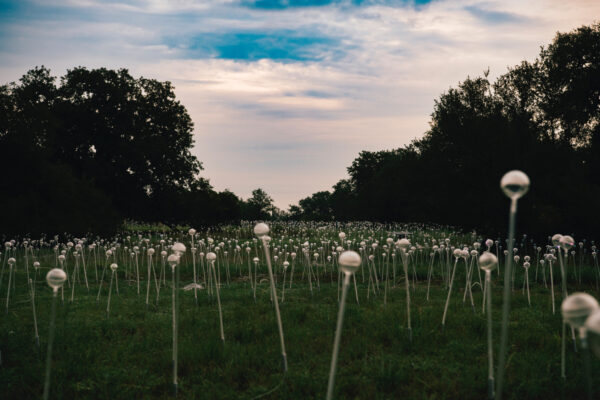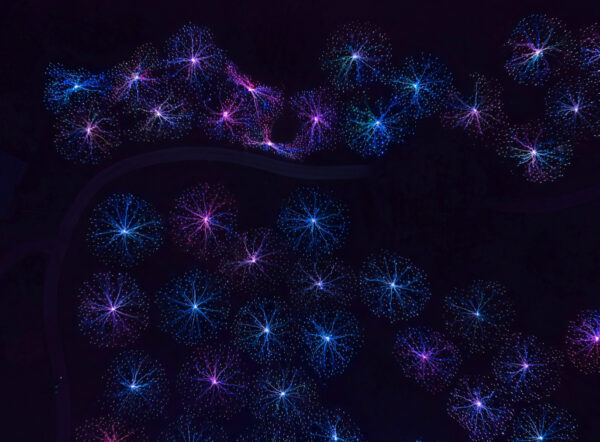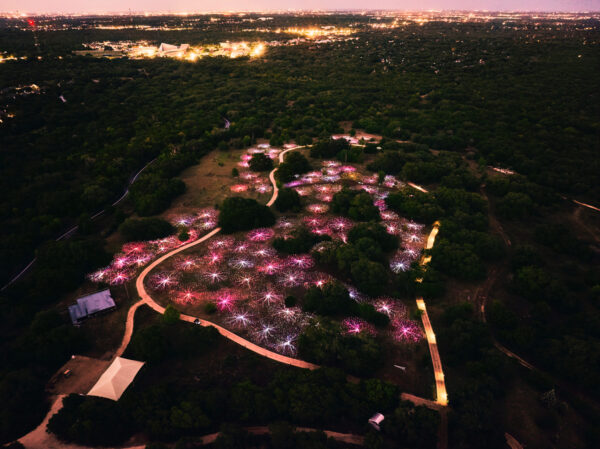
Bruce Munro, “Field of Light,” 2022, installation view at the Wildflower Center, Austin. Credit: Charles Reagan Copyright © 2022 Bruce Munro. All rights reserved.
Something new is blooming at Lady Bird Johnson Wildflower Center, but you’ll want to catch it as the sun goes down. That’s when thousands of solar-powered lights awaken with color and life in an art-via-nature experience known aptly as Field of Light. Dreamt up by British artist Bruce Munro, the grand-scale installation blankets much of the arboretum’s 16 acres with “stemmed spheres” connected by fiber optic cords running along the ground like a magical mycological network.
I attended the opening on a perfect evening in early September, and strolled along the arboretum’s trail as the bulbs began to flicker — before bumping into the artist himself. He was busy chatting with a 5-year-old attendee. How does it make you feel? he asked the little girl, who expressed wanting very much to paint the whole nummy thing. Looking out onto the dusting of light, mirroring the pale sunset behind us, I had to concur.
Field of Light has graced a number of outdoor settings, from England to Australia, to wine country in California. Munro came up with the initial idea 30 years ago, while camping in the Australian Outback — an experience that he says left a profound and lasting impression. A painter by training, Munro has toggled back and forth between creative and commercial pursuits for much of his life. Not long after graduating university with a degree in Fine Art, he left England and headed to Australia for a six-month adventure that lasted eight years. During that time, he started a lighting display business and eventually moved into manufacturing and production.

Bruce Munro, “Field of Light,” 2022, installation view at the Wildflower Center, Austin. Credit: Charles Reagan Copyright © 2022 Bruce Munro. All rights reserved.
Toward the end of his tenure Down Under, Munro went on an epic road trip with his fiancée through the continent’s Red Centre. While camping at Uluru, a sacred aboriginal site — and the world’s largest single rock monolith — the artist experienced an indescribable connection to the place. What followed was an idea to join nature, beauty, and light that “would bloom at night like dormant desert seeds responding to rain.”
Uluru is thousands of miles, and millions of years, into the henna red heart of the Australian continent. The rock itself is a colossal sandstone canvas that continually changes color with the sun’s movements, from violet to fire and gold. I was there half a life ago, and opted to walk around — rather than up — its steep climb, out of trepidation, and respect for the locals, who have lived in the area for the last 30,000 years. Our van arrived very early that morning, with all eight passengers jostling in sleepy silence toward the rock in the dark. Its outline appeared on the horizon like an ancient god as Paul Simon sang Diamonds on the Soles of Her Shoes on the radio. I relayed this memory to Mr. Munro:
“I can’t say I was listening to that,” he said with a smile, “but it’s interesting because we have two iterations. One is with frosted glass, where we just have the fiber coming into the sphere and that’s very soft, sort of almost like little moons. Whereas this one with the clear glass, and the fiber curled up, has a sparkle, which is a bit like diamonds.”

Bruce Munro, “Field of Light,” 2022, installation view at the Wildflower Center, Austin. Credit: Charles Reagan Copyright © 2022 Bruce Munro. All rights reserved.
Field of Light is illuminated by 28,000 diamonds to be exact, each one ignited by a squiggle of filament that gives off a pulsating twinkle. It’s best to arrive by dusk: watching it all come to life is both the orchestra tuning to concert pitch and the symphony itself. When the sun is long gone, a groundswell of pinks and blues (and warm hues in between) awaken those dormant desert seeds the artist once dreamed of.
The Australian Outback has this way of showcasing unfathomable scales of existence; like an ocean of primordial connection. Munro mentioned that it was, in fact, an inland sea hundreds of millions of years ago, but a very gentle sea, as fossils of tiny creatures have been found on top of nearby King’s Canyon. We both stood there for a moment and politely contemplated geologic time.

Bruce Munro, “Field of Light,” 2022, installation view at the Wildflower Center, Austin. Credit: Charles Reagan Copyright © 2022 Bruce Munro. All rights reserved.
Not long after visiting Uluru, Munro returned to England, married his fiancée, and started a family. Life as a full-time painter proved tricky, so he started a tile business and resumed his work in lighting design. Ten years went by before he recommitted to his art, and the ideas that followed him home from the desert. He bought a 16th-century farmhouse in Wiltshire, South West England, and began playing with large-scale light installations on the property, where he launched his first Field of Light in 2004. It has since expanded into various iterations around the globe, including Uluru in 2016, where the artist fulfilled a long-held dream that began in that very landscape.
And how does it make you feel? I asked as we looked out onto his field of light on opening night in the Outback of Austin.
“All I wanted was to convey that sense of how alive we feel. And joy. Simply the joy of being alive.”
Field of Light runs through the end of December at Lady Bird Johnson Wildflower Center. Timed-entry tickets are available here.



1 comment
Beuatiful! We loved presenting Bruce Munro’s Field of Light at Discovery Green in 2014. The softly glowing light field was installed under the majestic live oak canopy, creating a harmonious space for nature and art in the heart of downtown Houston.